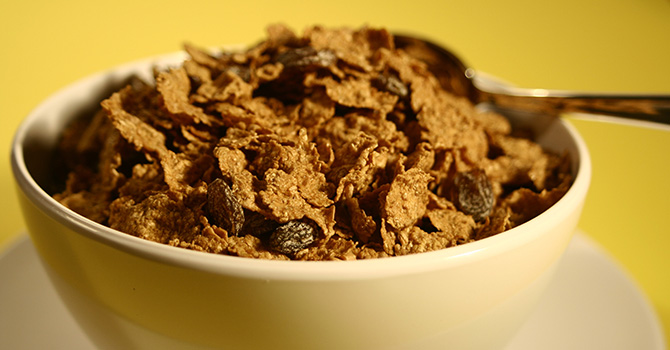4 Ways Fiber Benefits Your Health

Elyse Cloeter
MPH Candidate, Nutritional Sciences
Dietary fiber. We are told that we should eat more of it, but where do we find fiber? Is it an orange-flavored powder mix we stir into a glass of water? Is fiber the bland cereals that accompany the morning routines of older adults? Is fiber for everyone?
The Institute of Medicine (IOM) defines dietary fiber as "non-digestible carbohydrates and lignin that are intrinsic and intact in plants".1 Fiber is a component of plant-based foods that is indigestible in the human gut. We need it, but don't digest it. So why is it beneficial?
While humans don't have digestive enzymes that break down fiber, bacteria in our gut do. The intestinal microbiome use fiber from our diet as their own energy source; thus, dietary fiber promotes a healthy colon.
When our gut bacteria break down fiber, they produce short chain fatty acids (SCFAs). Humans can digest SCFAs for energy, and a symbiotic relationship between the digestive system and our colon's microbiome ensues. Ultimately, for every gram of fiber we consume, we receive two calories of energy in the form of SCFAs.2 That's incredible, considering our enzymes aren't even the ones doing the digesting.
There are two types of fiber—soluble and insoluble.3 Soluble fiber creates a gel-like substance in our gut that slows absorption of other nutrients into our body. Insoluble fiber doesn't dissolve in water. Instead, it takes up space in our gut, contributing to the notion of "roughage" often associated with fiber. Insoluble fiber promotes bowel movement by increasing stool "bulk."
| Soluble Fiber | Insoluable Fiber |
| Oats | Whole wheat flour |
| Peas, beans | Wheat bran |
| Vegetables (e.g., beets, eggplant) | Nuts, seeds |
| Fruits (e.g., plums, bananas, peaches) | Beans, lentils |
| Citrus fruits | Vegetables (e.g., cauliflower, broccoli, carrots) |
| Barley | Fruits (e.g., pears, apples, kiwi) |
Beyond providing a little extra energy, eating dietary fiber has health benefits that can be embraced by all people—not just the elderly!2
Some of the benefits of fiber include:
- Weight Management: Dietary fiber results in feeling full, which can help you avoid excessive food intake and aid in weight loss.
- Blood Sugar Control: Soluble fiber slows absorption of sugars into the bloodstream, which helps with diabetes management.
- Cholesterol Reduction: Fiber "binds up" cholesterol in the gut, preventing it from being absorbed, thereby reducing the risk of cardiovascular disease.
- Regularity of Bowel Movements: Insoluble fiber promotes regularity, relieving constipation and irritable bowel syndrome, and reducing the risk for hemorrhoids and diverticular disease.
The IOM recommends that people up to age 50 get consume 38 grams a day for men or 25 grams a day for women. For people older than 50, IOM recommends 30 grams a day for men or 21 grams a day for women.1
The Dietary Guidelines for Americans suggest simple ways that everyone can increase their fiber consumption:4
- Eat more fruits and vegetables.
- Make half of your grains whole grains.
- Consume a variety of plant-based foods.
- Focus on eating nutrient dense meals.
- Learn more about Nutritional Sciences at Michigan Public Health.
- Interested in public health? Learn more here.
Sources
- Institute of Medicine Food and Nutrition Board. Dietary Reference Intakes Proposed Definition of Dietary.; 2001. https://www.nap.edu/read/10161/chapter/2.
- The Academy of Nutrition and Dietetics. Position of the Academy of Nutrition and Dietetics : Health Implications of Dietary Fiber. J Acad Nutr Diet. 2015;115(11). doi:10.1016/j.jand.2015.09.003.
- Dhingra D, Michael M, Rajput H. Dietary fibre in foods : a review. 2012;49(June):255-266. doi:10.1007/s13197-011-0365-5.
- 2015 Dietary Guidelines Advisory. 2015-2020 Dietary Guidelines for Americans: Executive Summary.; 2017. https://health.gov/dietaryguidelines/2015/guidelines/executive-summary/.
About the Author
 Elyse Cloeter is a second-year Master of Public Health student studying Nutritional
Sciences at the University of Michigan School of Public Health. She is working to
become a registered dietitian and aspires to work in the field of maternal, child,
and family nutritional health. Cloeter grew up in Michigan and enjoys outdoor activities
and spending time on the lake during the summer.
Elyse Cloeter is a second-year Master of Public Health student studying Nutritional
Sciences at the University of Michigan School of Public Health. She is working to
become a registered dietitian and aspires to work in the field of maternal, child,
and family nutritional health. Cloeter grew up in Michigan and enjoys outdoor activities
and spending time on the lake during the summer.
